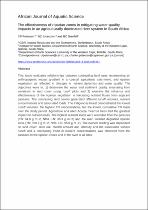 ResearchSpace
ResearchSpace
The effectiveness of riparian zones in mitigating water quality impacts in an agriculturally dominated river system in South Africa
JavaScript is disabled for your browser. Some features of this site may not work without it.
- ResearchSpace
- →
- Research Publications/Outputs
- →
- Journal Articles
- →
- View Item
| dc.contributor.author |
Petersen, Chantel R

|
|
| dc.contributor.author |
Jovanovic, Nebojsa

|
|
| dc.contributor.author |
Grenfell, MC

|
|
| dc.date.accessioned | 2020-08-21T09:57:38Z | |
| dc.date.available | 2020-08-21T09:57:38Z | |
| dc.date.issued | 2020-06 | |
| dc.identifier.citation | Petersen, C.R., Jovanovic, N. & Grenfell, M.C. 2020. The effectiveness of riparian zones in mitigating water quality impacts in an agriculturally dominated river system in South Africa. African Journal of Aquatic Science, vol 45(3), pp. 336-349 | en_US |
| dc.identifier.issn | 1608-5914 | |
| dc.identifier.issn | 1727-9364 | |
| dc.identifier.uri | https://doi.org/10.2989/16085914.2019.1685451 | |
| dc.identifier.uri | https://www.tandfonline.com/doi/abs/10.2989/16085914.2019.1685451 | |
| dc.identifier.uri | http://hdl.handle.net/10204/11552 | |
| dc.description | Copyright: 2019, NISC. Due to copyright restrictions, the attached PDF file contains the abstract of the full-text item. For access to the full-text item, please consult the publisher's website. | en_US |
| dc.description.abstract | This study evaluates relationships between contrasting land uses representing an anthropogenic impact gradient in a coastal agricultural catchment, and riparian vegetation, as reflected in changes in nutrient dynamics and water quality. The objectives were to: 1) determine the water and sediment quality emanating from variations in land cover using runoff plots and 2) examine the influence and effectiveness of the riparian vegetation in mediating nutrient fluxes from adjacent pastures. The contrasting land covers generated different runoff volumes, nutrient concentrations and associated loads. The indigenous forest demonstrated the lowest runoff volumes, the highest TN concentrations, but the lowest cumulative TN loads over the study period. Agriculture and alien Acacia mearnsii trees had the greatest impact on nutrient loads. The highest nutrient loads were recorded from the pastures (TN: 84.8 g m-2; NH4 +-N: 38.3 g m-2) and the alien invaded degraded riparian zone (TN: 100.7 g m-2; NH4 +-N: 55.6 g m-2). The nutrient loading was dependent on land cover, land use, rainfall amount and intensity and the associated surface runoff and a decreasing trend in nutrient concentrations was observed from the pastures to the riparian zones and to the river at all sites. | en_US |
| dc.language.iso | en | en_US |
| dc.publisher | NISC | en_US |
| dc.relation.ispartofseries | Workflow;23663 | |
| dc.subject | Ecotone | en_US |
| dc.subject | Land use | en_US |
| dc.subject | Nutrient loads | en_US |
| dc.subject | Surface runoff | en_US |
| dc.subject | Water | en_US |
| dc.title | The effectiveness of riparian zones in mitigating water quality impacts in an agriculturally dominated river system in South Africa | en_US |
| dc.type | Article | en_US |
| dc.identifier.apacitation | Petersen, C. R., Jovanovic, N., & Grenfell, M. (2020). The effectiveness of riparian zones in mitigating water quality impacts in an agriculturally dominated river system in South Africa. http://hdl.handle.net/10204/11552 | en_ZA |
| dc.identifier.chicagocitation | Petersen, Chantel R, Nebojsa Jovanovic, and MC Grenfell "The effectiveness of riparian zones in mitigating water quality impacts in an agriculturally dominated river system in South Africa." (2020) http://hdl.handle.net/10204/11552 | en_ZA |
| dc.identifier.vancouvercitation | Petersen CR, Jovanovic N, Grenfell M. The effectiveness of riparian zones in mitigating water quality impacts in an agriculturally dominated river system in South Africa. 2020; http://hdl.handle.net/10204/11552. | en_ZA |
| dc.identifier.ris | TY - Article AU - Petersen, Chantel R AU - Jovanovic, Nebojsa AU - Grenfell, MC AB - This study evaluates relationships between contrasting land uses representing an anthropogenic impact gradient in a coastal agricultural catchment, and riparian vegetation, as reflected in changes in nutrient dynamics and water quality. The objectives were to: 1) determine the water and sediment quality emanating from variations in land cover using runoff plots and 2) examine the influence and effectiveness of the riparian vegetation in mediating nutrient fluxes from adjacent pastures. The contrasting land covers generated different runoff volumes, nutrient concentrations and associated loads. The indigenous forest demonstrated the lowest runoff volumes, the highest TN concentrations, but the lowest cumulative TN loads over the study period. Agriculture and alien Acacia mearnsii trees had the greatest impact on nutrient loads. The highest nutrient loads were recorded from the pastures (TN: 84.8 g m-2; NH4 +-N: 38.3 g m-2) and the alien invaded degraded riparian zone (TN: 100.7 g m-2; NH4 +-N: 55.6 g m-2). The nutrient loading was dependent on land cover, land use, rainfall amount and intensity and the associated surface runoff and a decreasing trend in nutrient concentrations was observed from the pastures to the riparian zones and to the river at all sites. DA - 2020-06 DB - ResearchSpace DP - CSIR KW - Ecotone KW - Land use KW - Nutrient loads KW - Surface runoff KW - Water LK - https://researchspace.csir.co.za PY - 2020 SM - 1608-5914 SM - 1727-9364 T1 - The effectiveness of riparian zones in mitigating water quality impacts in an agriculturally dominated river system in South Africa TI - The effectiveness of riparian zones in mitigating water quality impacts in an agriculturally dominated river system in South Africa UR - http://hdl.handle.net/10204/11552 ER - | en_ZA |





